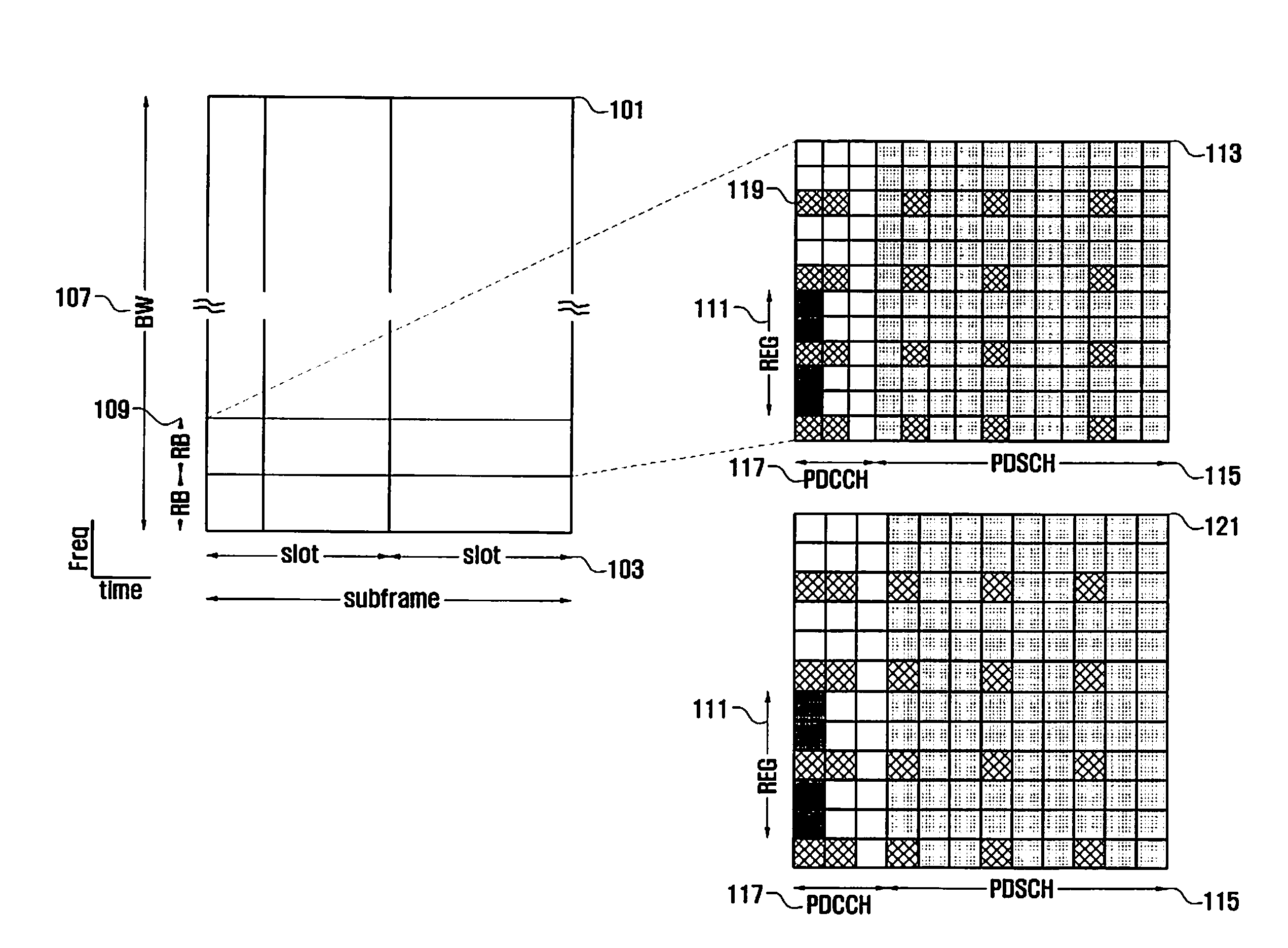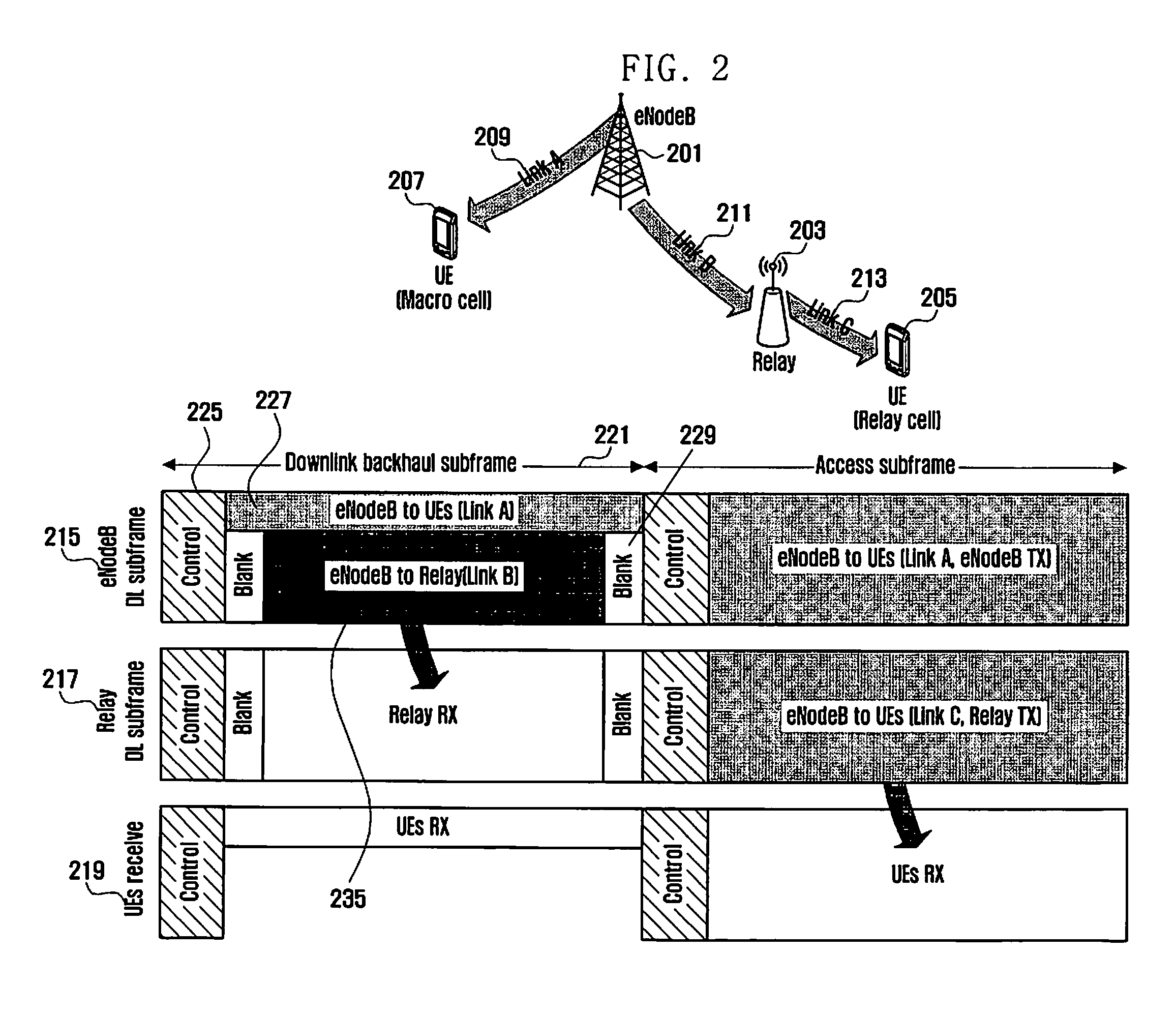Method and apparatus for transmitting/receiving control channel
a control channel and control channel technology, applied in the field of methods, can solve the problems of channel environment affecting channel operation, channel monitoring, channel demodulation, etc., and achieve the effect of reducing resource waste and efficient multiplexing
- Summary
- Abstract
- Description
- Claims
- Application Information
AI Technical Summary
Benefits of technology
Problems solved by technology
Method used
Image
Examples
first embodiment
[0068]FIG. 7 is a diagram illustrating a method for transmitting an R-channel according to a first embodiment of the present invention. In this embodiment, as the R-PDCCH is composed in units of RBs, a demultiplexer is used to concentrate the resource regions that are not used into an RB in order to avoid unnecessary resource waste.
[0069]Referring to FIG. 7, the R-region 709 includes the previously assigned resources for transmitting the R-PDCCH in the upper layer and is composed of K RBs 703 across L symbols 707 and 735. In the R-region 709, M RBs 703 and 733 are actually used to transmit the R-channels 701 and 729. Here, M is less than or equal to K and can be changed according to the channel condition in the current backhaul subframe between the base station and relay or the number of the relays involved in the transmission. In this embodiment, it is assumed that the relay knows the value M through other channels such as R-PCFICH.
[0070]That is, the R-region 709 is composed of M R...
second embodiment
[0073]FIG. 8 is a diagram illustrating a method for transmitting an R-channel according to a second embodiment of the present invention. Since the resource structure of the R-channel that is described in the first embodiment is used in the second embodiment, a detailed description of the resource structure of the R-channel is omitted herein.
[0074]Referring to FIG. 8, the R-region 809 includes the resources assigned previously for transmitting the R-PDCCH by the upper layer and is composed of K RBs 803 and 835 across the L symbols 807 and 839. Actually, M RBs 803 and 835 are used for transmitting the R-channel 801 and 833 in the R-region 809. In this embodiment, there is no need for the base station to report the value M of the relay through a separate channel. For this, the aggregation levels of the entire R-PDCCHs are fixed to one level in the type B resource 815 and 819. Also, resource interleaving is performed in units of R-PDCCHs.
[0075]As a result of interleaving, since the R-PD...
third embodiment
[0076]FIG. 9 is a diagram illustrating a method for transmitting an R-channel according to a third embodiment of the present invention. Since the resource structure of the R-channel that is described in the first and second embodiments is used in the third embodiment, a detailed description on the resource structure of the R-channel is omitted herein.
[0077]Referring to FIG. 9, the R-region 909 includes the resources assigned previously for transmitting the R-PDCCH by the upper layer and is composed of K RBs 903 and 933 across the L symbols 907 and 935. Actually, M RBs 903 and 933 are used for transmitting the R-channel 901 and 929 in the R-region 909. In this embodiment, it is assumed that the value M is informed to the relay through a separate channel such as the R-PCFICH. The type B resource 915 and 919 is composed of the R-PDCCHs of different aggregation levels that are random from the view point of the relay. That is, the base station determines the size of the type B resource 9...
PUM
 Login to View More
Login to View More Abstract
Description
Claims
Application Information
 Login to View More
Login to View More - R&D
- Intellectual Property
- Life Sciences
- Materials
- Tech Scout
- Unparalleled Data Quality
- Higher Quality Content
- 60% Fewer Hallucinations
Browse by: Latest US Patents, China's latest patents, Technical Efficacy Thesaurus, Application Domain, Technology Topic, Popular Technical Reports.
© 2025 PatSnap. All rights reserved.Legal|Privacy policy|Modern Slavery Act Transparency Statement|Sitemap|About US| Contact US: help@patsnap.com



